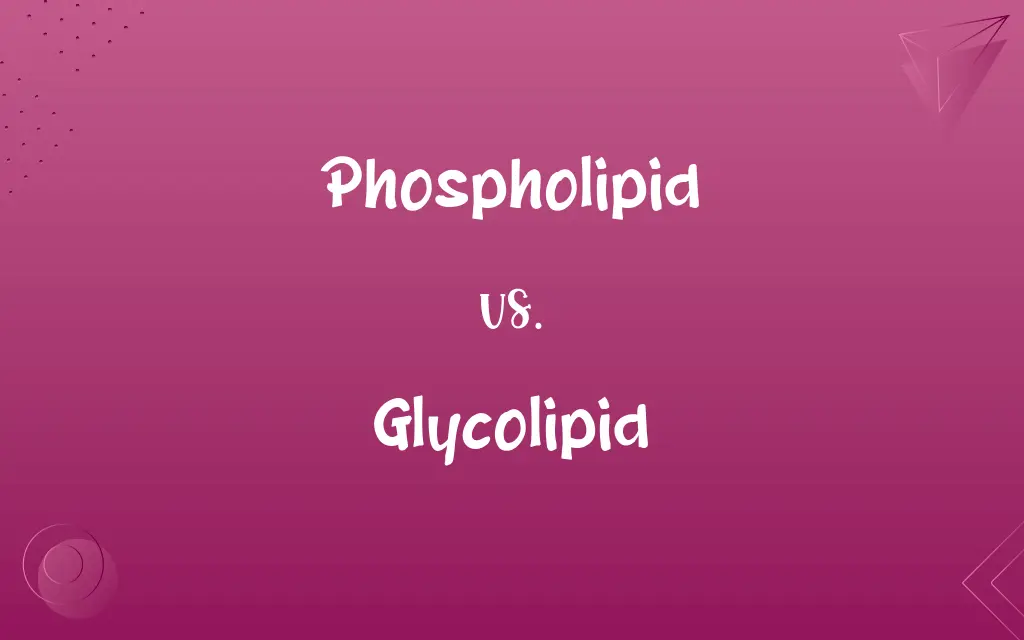Phospholipid vs. Glycolipid: Know the Difference

By Shumaila Saeed & Hifza Nasir || Published on July 10, 2024
Phospholipids are key components of cell membranes, featuring a phosphate group, while glycolipids contain a sugar molecule attached, playing roles in cell recognition and signaling.

Key Differences
Phospholipids are characterized by their unique structure, which includes a hydrophilic (water-attracting) head containing a phosphate group and two hydrophobic (water-repelling) fatty acid tails. Glycolipids, on the other hand, are composed of a sugar molecule attached to a lipid; their hydrophilic head is a carbohydrate, and they have one or more hydrophobic fatty acid tails.
Shumaila Saeed
Jul 10, 2024
Phospholipids play a crucial role in cell membrane fluidity and permeability, enabling the passage of ions and molecules necessary for cell function. Glycolipids, while also contributing to membrane structure, are particularly important for cell recognition processes. They act as markers that can be recognized by other cells, facilitating communication and interaction between cells, such as in the immune system.
Shumaila Saeed
Jul 10, 2024
In terms of composition, phospholipids always contain a phosphate group, which is key to their function in cell membranes. Glycolipids, with their sugar moieties, are involved in more specific interactions, such as recognizing specific molecules on the surface of other cells, which is vital for processes like immune defense and tissue formation.
Shumaila Saeed
Jul 10, 2024
The distribution of these lipids within the cell membrane also differs. Phospholipids are found throughout the entire cell membrane, forming the basic structure of the bilayer. Glycolipids are primarily located on the extracellular surface of the cell membrane, where their carbohydrate chains can interact with the external environment, mediating interactions with other cells and molecules.
Hifza Nasir
Jul 10, 2024
Despite their differences, both phospholipids and glycolipids are essential for the life of the cell. Phospholipids provide the fundamental structure and barrier function of the cell membrane, while glycolipids add to this structure and play key roles in cell recognition and signaling.
Hifza Nasir
Jul 10, 2024
ADVERTISEMENT
Comparison Chart
Structure
Hydrophilic head with phosphate, two hydrophobic tails
Hydrophilic carbohydrate head, one or more hydrophobic tails
Shumaila Saeed
Jul 10, 2024
Role
Forms cell membrane, barrier, and signaling
Cell recognition, signaling, immune response
Shumaila Saeed
Jul 10, 2024
Location in Cell Membrane
Throughout bilayer
Primarily on the extracellular surface
Shumaila Saeed
Jul 10, 2024
Function in Membrane
Barrier, fluidity, permeability
Cell-cell recognition, interaction
Hifza Nasir
Jul 10, 2024
ADVERTISEMENT
Phospholipid and Glycolipid Definitions
Phospholipid
Integral for cell membrane fluidity and permeability.
Phospholipids allow certain molecules to pass through the cell membrane selectively.
Shumaila Saeed
Mar 04, 2024
Glycolipid
A lipid with one or more attached sugar molecules, involved in cell recognition.
Glycolipids on the cell surface help the immune system recognize foreign invaders.
Shumaila Saeed
Mar 04, 2024
Phospholipid
A lipid containing a phosphate group, forming the main structure of cell membranes.
Phospholipids self-assemble to create a bilayer, essential for cell life.
Shumaila Saeed
Mar 04, 2024
Glycolipid
Play a key role in cell-cell interactions and signaling.
Glycolipids are crucial for the communication between cells in tissue formation.
Shumaila Saeed
Mar 04, 2024
Phospholipid
Involved in cellular signaling pathways.
Phospholipids in the membrane can activate signaling cascades in response to external signals.
Hifza Nasir
Mar 04, 2024
ADVERTISEMENT
Glycolipid
Contribute to the membrane's structure while facilitating specific interactions.
Besides structural support, glycolipids enable precise molecular recognition.
Dua Fatima
Mar 04, 2024
Phospholipid
Essential for creating a barrier between the cell and its environment.
Phospholipids form a selective barrier that protects the cell interior.
Hifza Nasir
Mar 04, 2024
Glycolipid
Found on the extracellular surface of the cell membrane.
Glycolipids extend outward from the cell membrane to interact with the environment.
Shumaila Saeed
Mar 04, 2024
Phospholipid
Amphiphilic, with both hydrophilic and hydrophobic parts.
The amphiphilic nature of phospholipids ensures they are perfectly suited for membrane formation.
Dua Fatima
Mar 04, 2024
Glycolipid
(biochemistry) An association of a carbohydrate and a phospholipid, such as phosphatidylinositol, found in cell membranes
Shumaila Saeed
Mar 03, 2024
Phospholipid
(organic compound) Any lipid, such as lecithin or cephalin, consisting of a diglyceride combined with a phosphate group and a simple organic molecule such as choline or ethanolamine; they are important constituents of biological membranes.
Shumaila Saeed
Mar 03, 2024
Phospholipid
Any of various compounds composed of fatty acids and phosphoric acid and a nitrogenous base; an important constituent of membranes
Shumaila Saeed
Mar 03, 2024
Phospholipid
Any of various phosphorus-containing lipids, such as lecithin and cephalin, that are composed mainly of fatty acids, a phosphate group, and a simple organic molecule. Also called phosphatide.
Shumaila Saeed
Mar 03, 2024
Repeatedly Asked Queries
Why are phospholipids important for the cell membrane?
They provide essential structure, fluidity, and selective permeability, creating a barrier and facilitating signaling within the cell.
Hifza Nasir
Jul 10, 2024
How do glycolipids contribute to immune responses?
They act as markers for cell-cell recognition, helping the immune system identify and respond to pathogens.
Shumaila Saeed
Jul 10, 2024
Can glycolipids be found throughout the cell membrane?
No, they are primarily located on the extracellular surface of the cell membrane, where they mediate interactions with other cells and molecules.
Shumaila Saeed
Jul 10, 2024
What makes phospholipids amphiphilic?
Their structure includes a hydrophilic head with a phosphate group and hydrophobic fatty acid tails, allowing interaction with both water and fats.
Shumaila Saeed
Jul 10, 2024
What role do phospholipids play in cellular signaling?
Phospholipids are involved in signaling pathways, activating responses to external stimuli through their role in the cell membrane.
Dua Fatima
Jul 10, 2024
How do phospholipids and glycolipids work together in the cell membrane?
While phospholipids form the membrane's structural bilayer, glycolipids contribute to its functionality by mediating cell recognition and signaling.
Shumaila Saeed
Jul 10, 2024
Are glycolipids only important for the immune system?
While crucial for immune responses, glycolipids also play roles in cell-cell communication and tissue organization.
Dua Fatima
Jul 10, 2024
Do glycolipids vary between different organisms?
Yes, the specific structures of glycolipids can vary, influencing their roles in cell recognition and signaling.
Hifza Nasir
Jul 10, 2024
Can the composition of phospholipids affect cell membrane properties?
Yes, variations in phospholipid composition can influence membrane fluidity and permeability, affecting cell function.
Shumaila Saeed
Jul 10, 2024
How are glycolipids involved in tissue formation?
They facilitate cell-cell recognition and adherence, essential for the organization of cells into tissues.
Shumaila Saeed
Jul 10, 2024
What distinguishes phospholipids from glycolipids?
Phospholipids have a phosphate group and form the cell membrane's bilayer, while glycolipids contain sugar molecules and are involved in cell recognition.
Hifza Nasir
Jul 10, 2024
What is the significance of the phosphate group in phospholipids?
It contributes to the hydrophilic nature of the head, essential for the phospholipid's role in membrane structure and function.
Hifza Nasir
Jul 10, 2024
Share this page
Link for your blog / website
HTML
Link to share via messenger
About Author
Written by
Shumaila SaeedShumaila Saeed, an expert content creator with 6 years of experience, specializes in distilling complex topics into easily digestible comparisons, shining a light on the nuances that both inform and educate readers with clarity and accuracy.
Co-written by
Hifza Nasir






































































